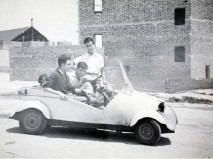1956 Biscuter Voisin Autonacional
Registration number: B-118537
Owner: Compra (Barcelona)
en.wikipedia.orgúter
Biscúter (Spanish spelling for the pronunciation of Biscooter) was a microcar manufactured in Spain during the mid-20th century.
The car had its origins in France in the late 1940s, where aircraft and car designer and manufacturer Gabriel Voisin had designed a minimal car called the Biscooter for Avions Voisin. The playful name implied that it was about the size of two motorscooters, or a scooter with four wheels. The design drew no interest from either manufacturers or consumers there, however, and he eventually licensed it to Spanish firm Autonacional S.A. of Barcelona. By the time it was introduced in 1953, the marque had been hispanicized to Biscúter. The first car had no formal model name and was called simply the Series 100, but it soon became known as the Zapatilla, or little shoe (clog), after a low-heeled peasant slipper popular at the time.
The Zapatilla was minimal indeed, with no doors or windows or reverse gear. The 1 cylinder, 197 cc, two-stroke motor produced 9 horsepower (7 kW), had a crank starter, and drove only the right front wheel. Braking was by an unusual three-point system involving the transmission and cable ties to the two rear wheels. One genuinely advanced feature was an all-aluminum body, although steel was later used.












